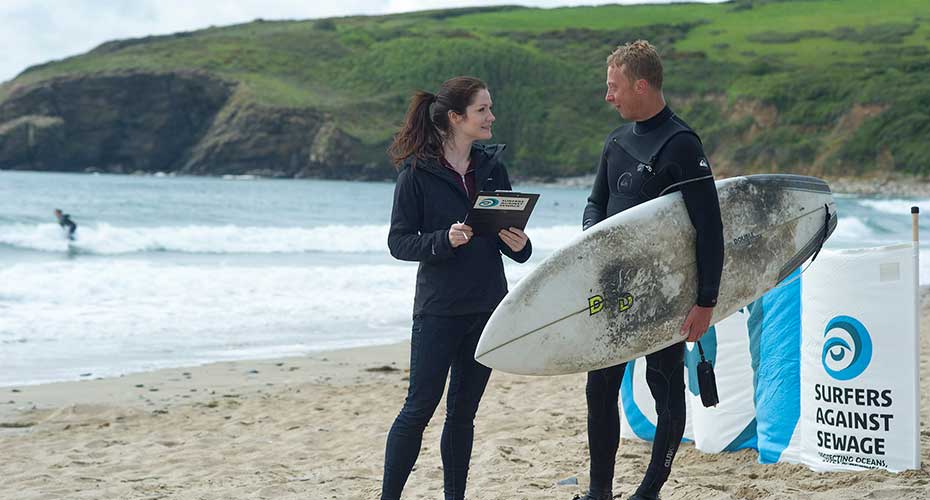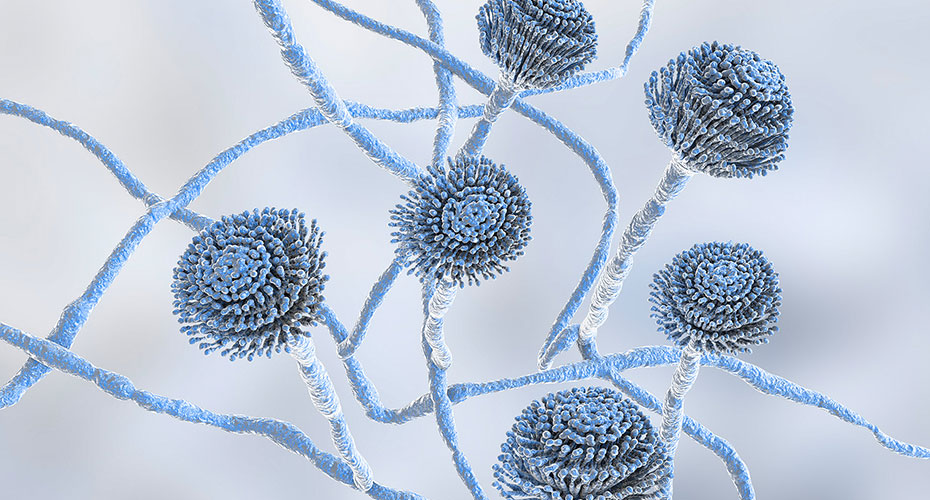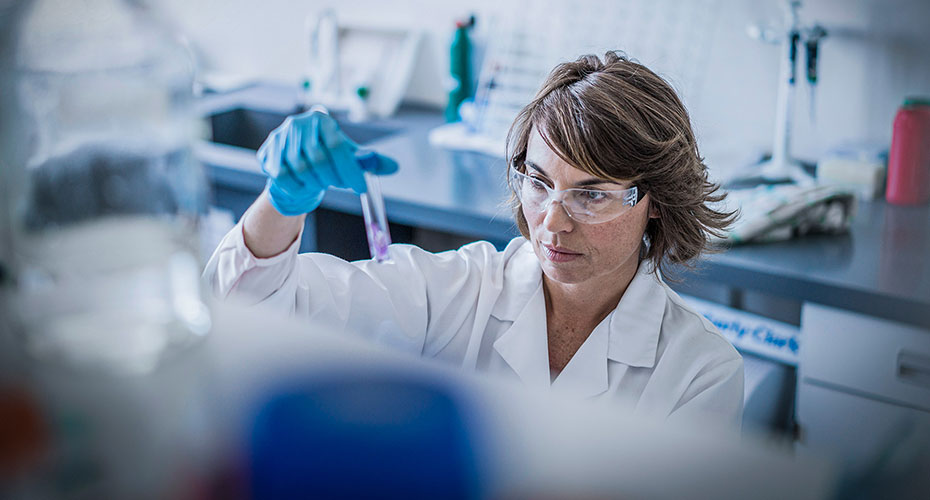Stemming the tide of AMR in the natural environment
5 December 2020
6 mins to read
In focus
Like plastic waste, a reservoir of resistant bacteria has built up in our environment over decades, and antimicrobials are continually introduced. When we take a dip in the sea, we are swimming in water that contain resistant bacteria which we can, and probably will, ingest.
The prevalence of AMR in the environment starkly highlights the complex cycle of antimicrobial use and spread of resistance. When we take antimicrobial drugs, around seventy per cent passes through our bodies into sewers. While many of the billions of human faecal bacteria are removed via waste water treatment plants, some also find their way into our rivers and the sea. This is also true of animal waste – when it rains, run-off from farms contributes to the problem. Antimicrobials are also used in agriculture and fish farming again creating effluents that contain antimicrobial compounds.
In these waters, resistance may actively evolve where antimicrobials are above a selective threshold. Resistant bacteria can then find their way back into our bodies, for example when we swim in the sea or eat contaminated food. Exeter’s One Health research approach combines a wide range of expertise to address this complex issue from all angles.
The broadest view
Professor William Gaze, of the University of Exeter Medical School and its European Centre for the Environment and Human Health said: “The problem of AMR covers every aspect of life and science, creating health and economic impacts globally. For example, higher temperatures associated with climate change may lead to increased survival of human gut bacteria in the environment and increased flooding will increase transmission through human exposure to polluted water.
“We have to take a broader holistic view to see how all the different elements of AMR relate to each other, including the contribution of natural and farmed environments. Our group is unique, in that we look at the combination of AMR evolution, the spread of AMR within the environment, and finally the impact of environmental transmission on human health. This highly unusual approach gives Exeter the ability to undertake joined-up thinking to tackle the problem.”
Professor Gaze’s expertise in AMR emerges from his background as a marine biologist investigating microorganisms in freshwater and deep sea marine systems, before focusing on AMR nearly 20 years ago. The proximity of the coast is no accident to how the research on human exposure in coastal bathing waters has developed. From their base at the Penryn Campus, in Cornwall, the team can see the coastline, and the Environment Agency national bathing water testing lab is conveniently located in the region. Professor Gaze is an active member of the movement not only to combine research disciplines to tackle AMR, but to unite researchers, stakeholders and policy makers.
"We have to take a broader holistic view to see how all the different elements of AMR in the environment integrate together. Our group is unique, in that we look at the combination of evolution, the spread of transmission in the environment, and finally we look at the impact of transmission in the environment. This highly unusual approach gives Exeter the ability to join-up thinking to tackle the problem."
Professor William Gaze
University of Exeter Medical School


What concentration drives resistance?
In one strand of work, Professor Gaze and the team look at whether the very low concentrations of antibiotics found in our waters can drive resistance. To analyse the complex communities of the billions of bacteria that are found in every single gram of sediment or soil, they use tools including metagenomics. After extracting DNA, they sequence a sub-sample of the genomes and characterise the resistance genes. They also apply quantitative PCR – now widely used in diagnosing COVID-19 infection. This allows them to calculate the prevalence of AMR in environmental communities of bacteria.
Working with AstraZeneca, Dr Aimee Murray and Dr Isobel Stanton found that the antibiotic ciprofloxacin poses the highest risk of driving resistance selection, even at the low concentrations at which it can be found in the environment. They also found that the antibiotic trimethoprim drives resistance, this antibiotic has subsequently been added to the Water Framework Directive’s Hazardous Compounds Watch List of chemicals that may pose a threat to environmental or human health. If more evidence emerges, limits could be imposed on the environmental discharge of these antibiotics.
As a next step, Dr Aimee Murray has developed an assay and a new environmental risk assessment framework that regulators can use in order to determine safe levels of antibiotics. In November 2020, the team presented their work to the All Party Parliamentary Group on Antibiotics.
Our impact on rivers
To understand how AMR bacteria behave in our waters, the team has also analysed whole river systems with colleagues at The University of Warwick and UK Centre for Ecology and Hydrology. In rivers, resistant bacteria are present at dramatically varying rates, which is dependent on how far away the nearest waste water treatment plant is, how large it is and what type of treatment happens there. “This tells us that we’re having a really major impact on the level of AMR in our environments,” said Professor Gaze. “Understanding this helps us think about mitigation strategies.”
The team also has a strong partnership with the Environment Agency. For years, they have analysed samples of E. coli, bacteria found in the human gut but also present in river and seawater, used as a marker of water quality in natural bathing waters. Dr Anne Leonard moved this work forward, looking specifically at human exposure to resistant E. coli bacteria.
Working with AstraZeneca, Dr Aimee Murray and Dr Isobel Stanton found that the antibiotic ciprofloxacin poses the highest risk of driving resistance selection, even at the low concentrations at which it can be found in the environment. They also found that the antibiotic trimethoprim drives resistance, this antibiotic has subsequently been added to the Water Framework Directive’s Hazardous Compounds Watch List of chemicals that may pose a threat to environmental or human health. If more evidence emerges, limits could be imposed on the environmental discharge of these antibiotics.
As a next step, Dr Aimee Murray has developed an assay and a new environmental risk assessment framework that regulators can use in order to determine safe levels of antibiotics. In November 2020, the team presented their work to the All Party Parliamentary Group on Antibiotics.

Beach bums: why surfers are susceptible
Working with the campaign charity Surfers Against Sewage, Dr Leonard conducted the Beach Bums survey, in which surfers were asked to take rectal swabs for analysis. Surfers were chosen as they’re known to swallow more water, and therefore more bacteria, than regular swimmers. The team found that surfers were more than three times as likely to carry resistant E. coli in their guts than non-swimmers.
“Carrying antibiotic resistant bacteria in your gut could potentially lead to infections which are difficult to treat. People may not display any symptoms when colonised, but they might suffer from infections in the future or pass on the resistant bacteria in their guts to other people, who may be more vulnerable.”
For the next step, Dr Leonard now has a Fellowship from the Natural Environment Research Council, to better understand the sources that contribute AMR bacteria to coastal waters.
"Carrying antibiotic resistant bacteria in your gut could potentially lead to infections which are difficult to treat. People may not display any symptoms when colonised, but they might suffer from infections in the future or pass on the resistant bacteria in their guts to other people, who may be more vulnerable."
Dr Anne Leonard
University of Exeter Medical School
Dr Leonard, herself a sea swimmer, said: “We don’t want to deter people from swimming in the sea or surfing. I live on the Cornish coast, and in the summer, I’m often in the sea. Research shows there are multiple benefits for both our physical and mental health when spending time outside and in blue spaces, such as the ocean. People can minimise their risk of being exposed to AMR including looking up the quality of the bathing water you are planning to visit.”
The research has had a number of policy influences in both the UK, the EU and internationally. Professor Gaze has worked with the United Nations Environment Programme, co-authoring its report on AMR, coinciding with a commitment to tackle the issue from an environmental and health perspective. The research has also informed plans for AMR surveillance being developed by the Environment Agency and the Government’s Department for the Environment, Food and Rural Affairs (Defra). Professor Gaze now works with Defra and the EA through a knowledge exchange programme which also brings in the pharmaceutical industry and the water industry. “It’s a really exciting change from conducting fundamental research to applying that research and working with policy makers and stakeholders to find solutions.”
Meet our researchers


Explore more research

Fungal resistance – an under-recognised crisis with massive global impact
Read more

AMR – uniting the disciplines to understand behaviour and influence change




